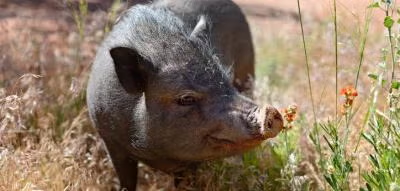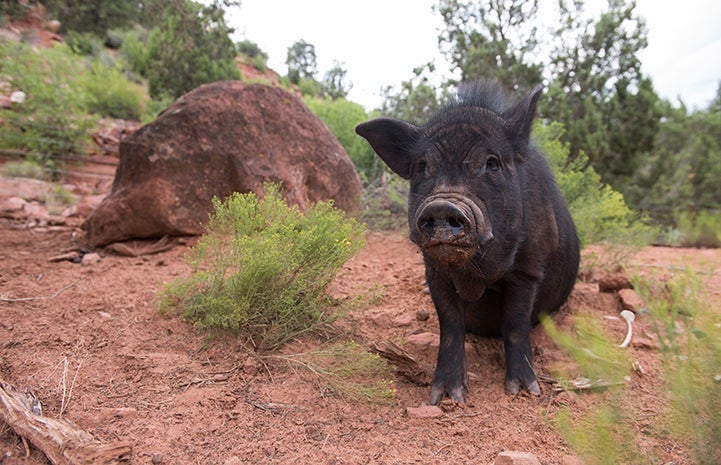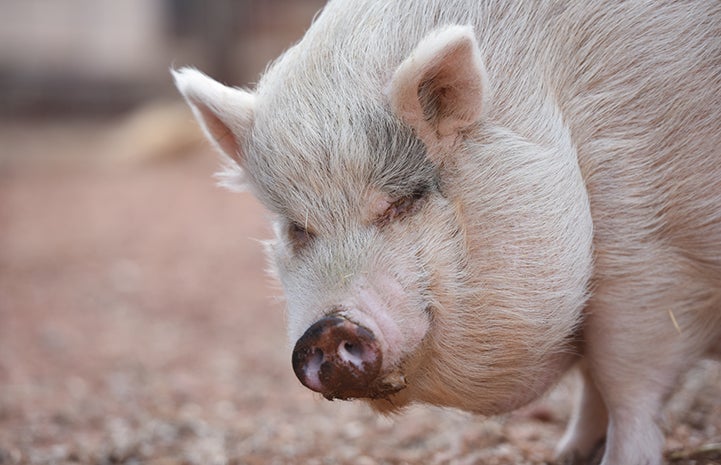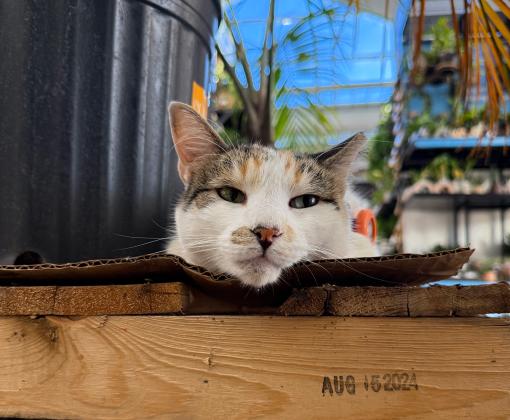
A Guide to Teacup Pigs (Mini Pigs)
Teacup pigs for sale? Buyer beware: Baby piglets might not be true teacup pigs — also known as mini pigs, micro pigs, dwarf pigs, pygmy pigs, and nano pigs. Pet pigs who stay small are more myth than reality. Here’s what you need to know if you’re considering adopting a teacup pig.
Do teacup pigs always stay small?
The term “teacup,” when used with dogs (such as a teacup Yorkie), is a way for breeders to claim their puppies will be even smaller than the breed’s smallest normal size. However, it’s a red flag that they’ve placed an emphasis on size rather than health. In fact, “teacup” is not recognized by any breed standard. And unfortunately, it leads to unhealthy, undersized animals (“runts,” if you will) being bred together, which increases and perpetuates health problems in their offspring.
So-called teacup pet pigs are all the same species: potbellied pigs. Originally bred in Vietnam, the potbellied pig is a domestic pig who is indeed miniature when compared to the average farm pig. While adult farm pigs can weigh around 1,000 pounds, most potbellied pigs end up somewhere between 100 and 200 pounds. So it’s not incorrect to call Vietnamese potbellied pigs mini within that context.
However, sometimes breeders use deceptive tactics to convince buyers that they're getting an especially small pig.
Baby pigs having babies
One of these tactics is breeding young pigs so that the breeder can tell a potential buyer, “Look at how small the parents are. The pig produced from these two will surely be small as well.” The problem is that pigs can breed at 4 months old, but they typically reach full height at around 3 years old and can continue to fill out and add weight until they are 4 to 5 years old.
Size is one of the primary reasons that pet potbellied pigs are surrendered to rescue groups and shelters. They are relinquished because their unsuspecting families had no idea their pigs would grow so large. Even if two 75-pound pigs are bred together, there’s no guarantee that the pigs born of those parents will also be only 75 pounds. A pig from that litter could be anywhere from 50 to 150 pounds when fully grown.
Extremely restrictive diet
Another tactic that some breeders use is sending their piglets out to new piggy parents with a contract stating that the pig should be fed exactly what the breeder recommends — no more, no less. Often, the prescribed amount of food is nowhere near enough to support a growing baby pig. The result is that the pig’s growth can become stunted, which can cause major medical issues.
The lack of food can also cause food-aggressive behaviors. Think about it: If you were hungry all the time, you’d probably get cranky. The same thing can happen with underfed pigs. If they don’t get enough to eat, they can become very food-aggressive: charging the dinner table; biting people’s legs or feet while they’re preparing meals; and even tearing apart cupboards, couches, and carpets in search of any tiny morsel of food. It is not uncommon for pet pigs to be surrendered to rescue groups and shelters for this reason.
Inbreeding of pigs
Inbreeding is another tactic that some breeders use in their attempts to create teacup pigs. Continually breeding parents to their babies or breeding siblings with one another are unsound breeding practices. It may result in offspring with the desired trait, but they usually also have unintended undesirable traits. Inbreeding can produce animals with low bone density, reduced immunity, failure to thrive, and decreased mental capacity. People who buy these pigs sometimes become overwhelmed by the pigs’ medical issues and end up relinquishing them.
At Best Friends, we took in one micro pig who was so delicate that her pink skin bruised at the lightest touch. Another tiny pig who came to the Sanctuary had been on a strict diet of yogurt and oatmeal (per her contract from the breeder). She ended up with intense front leg and shoulder pain, which our vet suspected was caused by a fracture due to low bone density.

See how your community is doing

How much do teacup pigs cost?
The cost of owning a teacup pig is nothing to sneeze at. Those who are looking to add a pet pig to their family will have a hard time finding cheap teacup pigs to purchase from breeders. The price range can be anywhere from several hundred to several thousand dollars. Then, be prepared to factor in a healthy pig diet, veterinary costs, and other care.
If you are looking for a porcine friend, please make adoption your only option. There are many reputable sanctuaries across the nation, and we are happy to refer you to one located near you.
Can mini pigs live in your house?
Pigs are very clean and intelligent animals. They can form close bonds with people and can be very affectionate and playful. They can even be clicker trained to learn basic training cues and tricks. People are often pleasantly surprised by just how smart they are and how unique each pig’s personality is.
However, in spite of what some breeders might say, living with even a small pet pig is not the same as having a dog or cat. While some pigs can be integrated successfully into a household, it won’t work for every person — or for every pig. Some pet pigs do enjoy spending time in a home hanging out with their family. But pigs also need to spend time outdoors with their snouts in the dirt, sniffing, rooting, and eating whatever tasty tidbits they find.
Pigs in the wild spend a large portion of their time rooting. If they don’t get to satisfy this natural behavior outside, they will do it inside — potentially at the expense of the family’s furnishings. A bored, frustrated pig can do a lot of damage quickly. Lack of mental stimulation for a pig can also lead to aggressive behavior toward humans, such as charging or biting. Pigs are social creatures, and even single pigs who spend time indoors with human family members tend to develop more behavioral problems than those who live with other pigs.
Furthermore, before bringing home a pet pig, check your local zoning laws and any HOA regulations. Pigs are often surrendered to shelters or turned loose when people find out that pigs are not legal where they live because they are considered farmed animals rather than pets.

'Teacup' pigs at Best Friends Animal Sanctuary
Best Friends Animal Sanctuary is a home between homes for dozens of pigs, many of whom were originally sold as teacup pigs.
Rosie was purchased as a baby teacup pig by a well-meaning couple who paid several thousand dollars for their new family member. Although they doted on her and followed the breeder's feeding instructions faithfully, Rosie became malnourished. As a result, her brittle bones were extremely prone to fractures. She became so fragile that she once bumped her leg while walking out of a dog door and suffered a hairline fracture.
Rosie grew stronger with a proper diet and care, but veterinarians still determined that she was deaf and had osteoporosis. At 140 pounds, she also outweighed her breeder’s size prediction of 100 pounds.

Cutie came to the Sanctuary when her people got a divorce. Though still fairly young, she was diagnosed with serious arthritis and a tender shoulder that was broken in the past.
Oliver, on the other hand, had the good fortune of staying fairly healthy. But at approximately 180 pounds, he grew much larger than his original family expected. He was purchased because of false advertising that led his people to expect him to stay tiny; when he didn’t, he ended up needing to be rehomed.
Boris, who was sold as a teacup piglet, was only a year old when he came to the Sanctuary. He was diagnosed with degenerative joint disease and major body conformation issues. Luckily, in spite of these issues, Boris managed to find a family who loved him and wanted to take him home.
Mini pigs in pop culture
Celebrities have boosted the visibility — and myth — of owning a mini pig. Although George Clooney had a pet pig for 18 years, the nano pig trend seems to have taken off in 2009 when Paris Hilton got a so-called teacup pig. Also in 2009, Victoria Beckham (of Spice Girls fame) bought her soccer-star husband, David Beckham, two teacup pigs as a Christmas gift. In 2012, child reality TV star Alana Thompson (better known as Honey Boo Boo) briefly had a baby mini pig named Glitzy whom she intended to take with her to beauty pageants as a good-luck charm. And singer Miley Cyrus posed with her pet teacup pig for the cover of a magazine in 2015.
While some celebrities have kept their teacup piglets even after they grew into adults, the pocket pig trend has had some serious ripple effects. The public often sees these pets when they are tiny piglets and not fully grown, and that perpetuates the false notion that pet pigs can stay small. Pet pigs are losing their homes as people buy them and then quickly realize that the pigs get much bigger than anticipated — and have many needs they didn’t expect.

Becoming an educated pig person
An educated public is the best defense against poor pig health and homelessness. Celebrities and other people displaying their pet pigs on social media, in magazines, and beyond are typically only showing part of what having a pig entails — and often only the best bits.
This certainly doesn’t mean people can’t enjoy having potbellied pigs for pets. It’s a matter of learning about pigs from reliable sources (such as rescue groups and veterinarians), knowing what to expect when bringing them home, and having the proper setup to keep a pig happy.
Spending time with fully grown pigs before taking that step can give people a big leg up on successfully keeping a pet pig. And because there are lots of pigs in rescue groups, shelters, and sanctuaries across the country, finding opportunities to spend time with them is easy. It doesn’t matter if those pigs were called teacup pigs, mini pigs, miniature pigs, micro mini pigs, dwarf pigs, or pygmy pigs in their past lives. After all, a potbellied pig is a potbellied pig.
